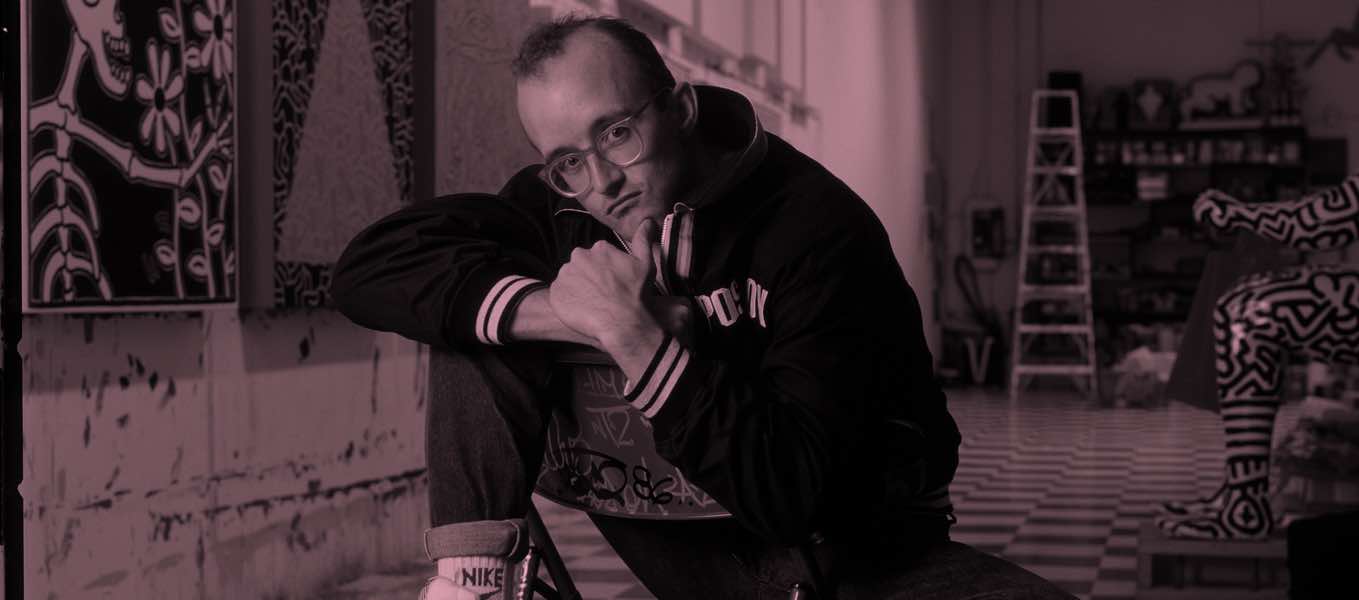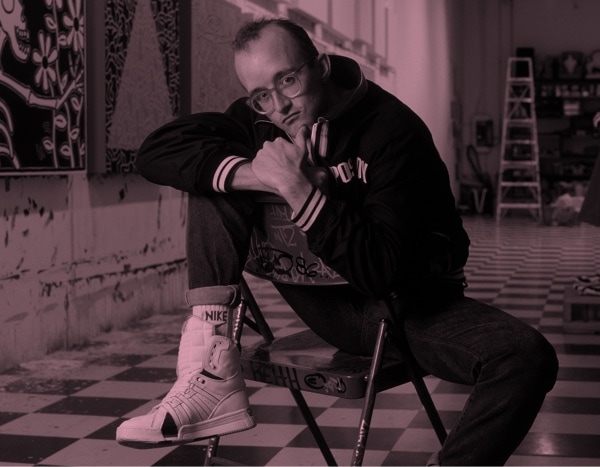Keith Haring
David Spada
Grace Jones’ Hat 1984
ink on metal
89.0 x 61.0 cm
The Keith Haring Foundation, New York
Keith Haring artwork © Keith Haring Foundation
Keith Haring
Untitled 1989
paint on cotton jacket
(a-b) 63.5 x 55.9 cm (variable) (each)
Collection of Larry Warsh
Keith Haring artwork © Keith Haring Foundation
Jean-Michel Basquiat
Hollywood Africans in Front of the Chinese Theater with Footprints of Movie Stars 1983
synthetic polymer paint and oilstick on canvas on wood panel
90.0 x 207.0 cm
The Estate of Jean-Michel Basquiat, New York
© Estate of Jean-Michel Basquiat. Licenced by Artestar, New York
Jean-Michel Basquiat
Ramm:ell:zee versus K.Rob, Beat Bop (Poster, cover and album design by Jean-Michel Basquiat) 1983
poster, cover and album design by jean-michel basquiat
30 x 30 cm; Vinyl, 12’’, 33 1/3 RPM
Collection Jennifer von Holstein
© Estate of Jean-Michel Basquiat. Licenced by Artestar, New York
Haring and Basquiat, along with many of their local contemporaries in the 1980s, sought to collaborate and overcome traditional barriers between artistic disciplines and cultural scenes. An important role model was Andy Warhol who, since the 1950s, had been constantly expanding his artistic practice to encompass painting, prints, drawings, photography, sculpture, film, fashion, television, performance, theatre, music and literature.
Haring adopted a similarly multidisciplinary approach to his practice, creating paintings, sculptures, prints, text-based works, videos and photographs. He also ‘performed’ his drawings in public spaces, often in front of an audience. Basquiat, too, was active as a draughtsman, painter, performer, actor, poet, musician, fashion model and DJ.
Both artists were regular participants in the Downtown New York club scene, a place where creative experimentation with fashion, music, performance and art thrived. At nightclubs, including Paradise Garage and Club 57, people could be themselves, regardless of race, sexuality or gender. It was in these spaces that Haring and Basquiat met, shared ideas and collaborated with other creatives such as Warhol, fashion designer Vivienne Westwood, and performers Madonna and Grace Jones. For both artists, oscillating between different artistic disciplines came naturally and anticipated the interdisciplinary practices of many artists in the 1990s, as well as the diversity in creative careers that is commonplace today.
哈林、巴斯奎特以及上世纪80年代的许多当地同行都在寻求合作,克服艺术学科和文化大背景之间的传统屏障。一个重要的榜样是安迪·沃霍尔,自20世纪50年代以来,他一直在不断扩大他的艺术实践,将绘画、版画、素描、摄影、雕塑、电影、时装、电视、表演、戏剧、音乐和文学囊括其中。
哈林在实践中采用了类似的多学科方法,创作了绘画、雕塑、版画、文字作品、视频和照片。他也会在公共场所“表演”自己的画作,通常是在观众面前。巴斯奎特也是一位活跃的画家、表演者、演员、诗人、音乐家、时装模特和DJ。
两位艺术家都是纽约下城俱乐部的常客,在那里,时尚、音乐、表演和艺术的创意实验蓬勃发展。在夜总会里(包括天堂车库和57俱乐部),不论种族、性取向或性别,人们可以做真实的自己。正是在这样的地方,哈林和巴斯奎特相遇、交流思想并与其他创意人员合作,如沃霍尔、时装设计师薇薇恩·韦斯特伍德、表演者麦当娜和格蕾丝·琼斯。对于这两位艺术家来说,在不同的艺术学科之间摇摆是自然的事,也可以预见到上世纪90年代许多艺术家的跨学科实践,以及如今司空见惯的创意职业的多样性。









